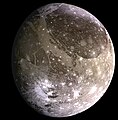ไฟล์:The Galilean satellites (the four largest moons of Jupiter).tif

ขนาดของตัวอย่าง JPG นี้ของไฟล์ TIF นี้: 800 × 262 พิกเซล ความละเอียดอื่น: 320 × 105 พิกเซล | 640 × 210 พิกเซล
ไฟล์ต้นฉบับ (1,830 × 600 พิกเซล, ขนาดไฟล์: 1.51 เมกะไบต์, ชนิดไมม์: image/tiff)
ประวัติไฟล์
คลิกวันที่/เวลาเพื่อดูไฟล์ที่ปรากฏในขณะนั้น
| วันที่/เวลา | รูปย่อ | ขนาด | ผู้ใช้ | ความเห็น | |
|---|---|---|---|---|---|
| ปัจจุบัน | 19:54, 29 ธันวาคม 2554 | 1,830 × 600 (1.51 เมกะไบต์) | Prof. Professorson | {{Information |Description=This composite includes the four largest moons of en:Jupiter which are known as the Galilean satellites. The Galilean satellites were first seen by the Italian astronomer en:Galileo Galilei in |
การใช้ไฟล์
1 หน้าต่อไปนี้ใช้ไฟล์นี้:
การใช้ไฟล์ข้ามโครงการ
วิกิอื่นต่อไปนี้ใช้ไฟล์นี้:
- การใช้บน af.wikipedia.org
- การใช้บน als.wikipedia.org
- การใช้บน ar.wikipedia.org
- การใช้บน ast.wikipedia.org
- การใช้บน az.wikipedia.org
- การใช้บน ba.wikibooks.org
- การใช้บน be-tarask.wikipedia.org
- การใช้บน be.wikipedia.org
- การใช้บน bg.wikipedia.org
- การใช้บน bn.wikipedia.org
- การใช้บน bn.wikibooks.org
- การใช้บน bs.wikibooks.org
- การใช้บน ca.wikipedia.org
- การใช้บน cs.wikipedia.org
- การใช้บน en.wikipedia.org
- การใช้บน en.wikibooks.org
- การใช้บน es.wikipedia.org
- การใช้บน et.wikipedia.org
- การใช้บน eu.wikipedia.org
- การใช้บน fi.wikipedia.org
- การใช้บน fr.wikipedia.org
- การใช้บน gl.wikipedia.org
- การใช้บน he.wikipedia.org
- การใช้บน hi.wikipedia.org
- การใช้บน hu.wikipedia.org
- การใช้บน hy.wikipedia.org
- การใช้บน id.wikipedia.org
- การใช้บน it.wikipedia.org
- การใช้บน ja.wikipedia.org
- การใช้บน kk.wikipedia.org
- การใช้บน ko.wikipedia.org
ดูการใช้ข้ามโครงการเพิ่มเติมของไฟล์นี้





